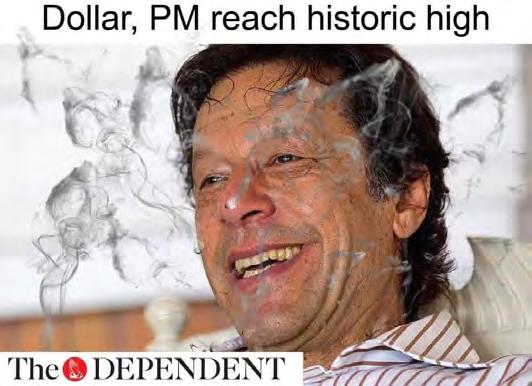
6 minute read
Injection or not - the rupee slide explained
By Ariba Shahid
There is a lot of buzz surrounding the rupee’s slide against the dollar and more importantly of an injection by the SBP into the forex market. In a scoop, Shehbaz Rana in the Express Tribune claims that the SBP pumped $1.2 billion into the interbank market in three months to defend the weakening rupee.
Advertisement
The Pakistani rupee on Wednesday continued its slide against the greenback, touching a new all-time low for the second straight day at 169.5 in the interbank market at the onset of trading session. The local currency had closed at an all-time low value of Rs168.94 a day earlier, on Tuesday. The rupee depreciated by 45 paisa against the greenback and was being quoted at 169.10 to 169.50 while trades were reported at 169.50.
The rupee, which has been termed the
Waqas Hussain, head of sales at Tresmark
worst-performing currency in Asia, seems to have opened the field for the bullish US dollar to move forward unchecked and erode the remaining value of the local currency, maintaining downturn since it touched a 22-month high of Rs152.27 in May 2021, losing a cumulative Rs17.36 in the past four months.
So is there any way to actually confirm an injection? If we’re being candid, there is no way to know for sure unless the SBP confirms it. Sources inside the SBP can hint towards it, but one can never be too sure. “SBP does not comment on speculations about market interventions,” said Qamar.
That means that official confirmation is not a possibility. However, they have also made
Sayem Z Ali, division head at Bank of Punjab

no effort at all to try and deny the incriminating numbers being presented. While some suggest that weekly changes in the SBP reserve positions may help determine whether this is true or not, it’s not that simple. Because if one is looking for a $1.2 billion withdrawal from reserves, it is not that simple considering there are also additions made to the reserves. Thus, this is itself not an accurate means.
“People are not clear on the interventions, as SBP does not make details public. So data and timing of these interventions are unknown,” says Sayem Z. Ali, Division Head at Bank of Punjab. “It is also very important to note that in the situation where an injection is made, it will be temporary. The SBP also stated that the interventions will be temporary and they will maintain a net zero position at the end of each quarter. so whatever they sell to the market, they will purchase back at a later date,” he explains.
Profit reached out to the SBP for a comment on the intervention and its nature. Abid Qamar, spokesperson at SBP said that since June 2019, Pakistan has adopted a market based flexible exchange rate system, where the exchange rate is determined by market demand and supply conditions. “Under this system, the role of SBP’s interventions in the FX market is limited to prevent disorderly market conditions, while not suppressing an underlying trend. When the exchange rate does not reflect realistic market conditions it can contribute to unsustainable current account deficits and repeated balance of payments problems.”
So what in the world has been going on exactly? What is up, or should we say what is down, with the rupee? There are a number of factors at play. “Usually, during volatility, the SBP used to issue statements explaining the reasons. However, they have gone into sleep mode. As per the last policy statement SBP stated that depreciation witnessed in the rupee is due to higher commodities prices and depreciation of regional currencies against the USD,” says Waqas Hussain, Head of Sales at Tresmark. With no such statement or comment currently, Profit has asked experts what they believe are the reasons behind the rupee’s behavior.
“The sharp rise in trade deficits and CAD over the last 3 months is showing a significant increase in demand for dollars (imports, freight charges, debt repayments etc) whereas supply (export, remittances etc) have not kept pace. so despite record high SBP reserves the demand supply equation necessitated a correction on the PKR,” says Ali. “Moreover, the $2.8 billion IMF SDR cannot be used for meeting import payments,” he reminds us.
On the trade front, commodities are adding pressure to the rupee. Rising international prices for commodities have not been kind to Pakistan. This means more dollars are spent to buy the same quantity Pakistan was buying. “We are short of major commodities such as wheat and sugar and have been importing them for some time. International commodity prices have also gone up, including oil. In addition, the government is making payments for the vaccines which is also putting pressure on the import bill,” says Hussain.
The TERF scheme by the SBP also means greater imports of machinery. Considering that it is expiring in December, there may be a greater rush for imports before that. Moreover, there has been an upswing in car sales which adds to the import bill considering Pakistan imports parts. All this means more outflows with exports not increasing by the same proportion. “On the CAD side, it is only a month or two that have been going out of control. These have had a disturbing impact on the market sentiments,” says Hussain.
However, international pressure on the rupee can also not be ignored. “We now have a serious situation in Afghanistan, which is further fueling demand for dollars. There is now greater demand from Afghanistan as people are dumping the local currency in exchange for the dollar,” says Ali. Hussain further adds how news outlets said that China has also asked for repayment for $3 billion. “Because Afghan reserves are frozen by the US federal bank, a lot of flows from the open market are going to Afghanistan, technically one could say Pakistan is unofficially bearing the burden of their trade.” n

Abid Qamar, spokesperson for the SBP


















